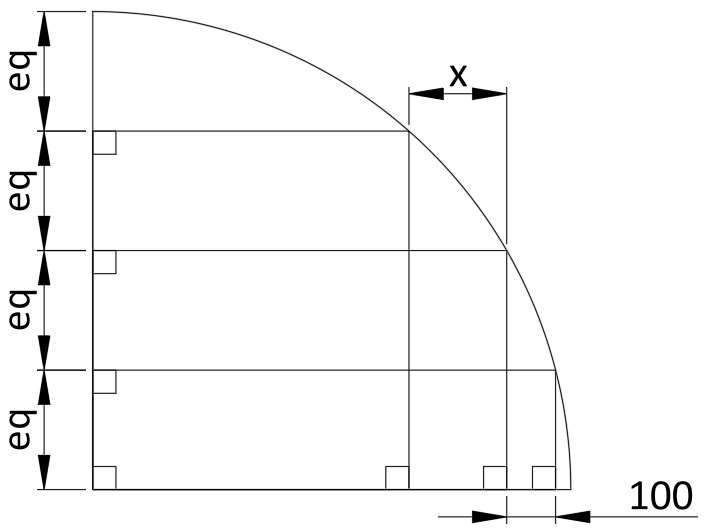Let’s call the equal heights h. The radius of the quarter circle and therefore also the diagonal of each of the three main rectangles is 4h. The horizontal length of each of those rectangles, let’s call them k,l,m can be found using Pythagoras:
k^2=(4h)2-h^2=15h^2
l^2=(4h)2-(2h)^2=12h^2
m^2=(4h)2-(3h)^2=7h^2
k=h*sqrt(15)
l=h*sqrt(12)
m=h*sqrt(7)
Now 100 and x are simply the difference between those lengths:
100=k-l=h*(sqrt(15)-sqrt(12))
x=l-m=h*(sqrt(12)-sqrt(7))
If we divide one equation by the other we can eliminate h:
x/100 = (sqrt(12)-sqrt(7))/(sqrt(15)-sqrt(12))
x/100 = 2.0014
x = 200.14, or 200 to the nearest integer.
Why should (sqrt(12)-sqrt(7))/(sqrt(15)-sqrt(12)) be so close to 2?
None of 7 12 or 15 is a square number so we can’t reduce them any further. When we factorise them nothing useful happens. However if we multiply each of them by 24, the above ratio will be preserved, and although 168, 288 and 360 still aren’t square numbers, the numbers just above them, 169, 289 and 361 all are (squares of 13, 17 and 19 respectively).
The value of (sqrt(289)-sqrt(169))/(sqrt(361)-sqrt(289)) is precisely 2, so it should come as no surprise that (sqrt(288)-sqrt(168))/(sqrt(360)-sqrt(288)) is so close to 2, and THAT ratio is precisely the same as the one in the question.
Why is it that when we multiply each of the numbers (7,12,15) by 24 we get a number one less than a square? Is that just a coincidence? Is it always possible so multiply a set of numbers by a particular factor so that the products are all one less than a square? These are interesting questions.
